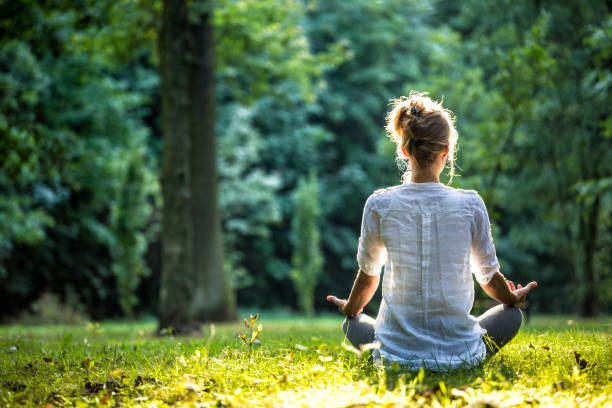Understanding the best types of meditation and their benefits is a great starting point for a beginner. Finding peace within ourselves can seem like an elusive dream in a world that moves at lightning speed, where our minds are bombarded with constant stimuli and our bodies pulled in a million directions. Yet, nestled within the ancient meditation practice lies the key to unlocking that tranquility we desperately seek. In this beginner’s guide, we embark on a journey to demystify meditation, explore its various forms, and offer practical tips to begin your transformative practice.

Understanding Meditation:
At its core, meditation is the art of stilling the mind and connecting with our inner selves. It’s a practice that has been embraced by cultures worldwide for thousands of years, offering a pathway to clarity, insight, and profound relaxation. While the ultimate goal of meditation may vary from individual to individual, its benefits are universally acknowledged:
- Stress Reduction: Meditation helps to quiet the constant chatter of the mind, allowing us to release stress and anxiety.
- Enhanced Focus: Meditation improves concentration and mental clarity by training our attention.
- Emotional Well-being: Through self-reflection and mindfulness, meditation fosters emotional resilience and a greater sense of compassion.
- Physical Health: Studies have shown that meditation can lower blood pressure, strengthen the immune system, and promote overall well-being.

Exploring Meditation Types:
Meditation is a diverse practice, with various techniques suited to different preferences and goals. Here are some of the most common types:
- Mindfulness Meditation: From Buddhist traditions, mindfulness meditation involves observing thoughts, emotions, and sensations without judgment. Practitioners often focus on the breath or bodily sensations, bringing their attention to the present moment.
- Transcendental Meditation (TM): TM involves using a mantra—a word or phrase—to anchor the mind and induce deep relaxation and heightened awareness. It’s a simple yet powerful technique that can be practiced anywhere.
- Loving-Kindness Meditation: Also known as Metta meditation, this practice cultivates feelings of love, compassion, and goodwill towards oneself and others. It typically involves silently repeating phrases of kindness and well-wishing.
- Visualization Meditation: Visualization techniques involve creating vivid mental images to evoke calmness, positivity, and inner strength. Practitioners may visualize serene landscapes, healing light, or personal goals and aspirations.
- Body Scan Meditation: In this practice, attention is systematically directed throughout the body, tuning into sensations and areas of tension. By cultivating body awareness, practitioners learn to release physical and emotional stress stored in different body parts.

Getting Started with Meditation:
Embarking on a meditation journey can feel daunting, but it’s essential to remember that, like any skill, meditation requires patience, persistence, and self-compassion. Here are some tips to help you get started:
- Start Small: Begin with just a few minutes of meditation each day, gradually increasing the duration as you become more comfortable with the practice.
- Create a Sacred Space: Designate a quiet, clutter-free area for your meditation practice. Surround yourself with objects that inspire calmness and serenity.
- Set Intentions: Before each meditation session, take a moment to set intentions for your practice. Whether cultivating peace, gratitude or simply being present, clarifying your purpose can enhance your meditation experience.
- Experiment with Techniques: Explore different meditation styles to find what resonates with you. Feel free to experiment and adapt your practice to suit your unique preferences and needs.
- Be Gentle with Yourself: Remember that meditation is not about achieving a state of perfection but rather about cultivating awareness and self-compassion. Be patient with yourself as you navigate the ups and downs of your meditation journey.

For someone just beginning their meditation journey, it’s important to approach the practice with patience and realistic expectations. Starting with short sessions, perhaps five to ten minutes, allows individuals to acclimate to the experience without feeling overwhelmed. Consistency matters more than duration at the outset, so aiming for regular, daily practice—even if brief—can yield significant benefits over time. As proficiency develops and comfort with meditation increases, gradually extending session lengths to 15 or 20 minutes becomes feasible. However, there’s no fixed timetable for progress; everyone’s meditation journey unfolds at its own pace. The key lies in embracing the process with an open mind and gentle perseverance, understanding that the benefits of meditation accrue gradually and are often subtle yet profound.

Meditation involves several crucial steps aimed at cultivating mindfulness and inner peace. First and foremost, finding a quiet and comfortable space free from distractions is paramount. Once settled, practitioners typically assume a relaxed yet alert posture, whether sitting cross-legged or lying down, with hands resting comfortably. Focusing on the breath is foundational, with attention directed towards the natural rhythm and sensation of inhalation and exhalation. As thoughts inevitably arise, the key lies in acknowledging them without judgment and gently guiding the focus back to the breath or a chosen point of concentration, such as a mantra or bodily sensations. Cultivating a non-reactive awareness of the fluctuations of the mind is fundamental, fostering a sense of detachment from wandering thoughts and emotions. Lastly, concluding the practice with a moment of gratitude or reflection can help integrate the benefits of meditation into daily life, promoting a greater sense of clarity, compassion, and presence.
In conclusion, meditation is a profound tool for self-discovery, healing, and personal growth. By embracing the practice of meditation and exploring its various forms, we open ourselves to a world of inner peace, clarity, and transformation. So, take a deep breath, quiet your mind, and embark on this beautiful journey of self-exploration. Your inner sanctuary awaits.
